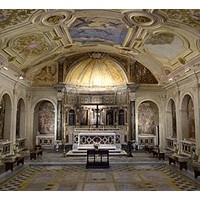
dal 1996 in continua innovazione tecnologica!
Sfrutta tecnologie avanzate per avere un sito web ottimizzato al 100%

The catacombs of San Gaudioso are one of the ancient cemetery buildings of the Early Christian Age (IV-V century), located in the northern part of the city of Naples (current Stella district).
Access to the catacombs is located in the crypt, or succorpo, beneath the elevated presbytery of the church called the Madonna della Sanità, which is depicted in a fresco that is detached from a wall of the ancient church following a landslide mud. The Virgin of Health (V-VI century), probably the most ancient Marian statue of Naples, is now preserved in the first right side chapel of the basilica. Many neighborhood residents believe, however, that the church is named after St. Vincenzo Ferreri because of the popular devotion to this Dominican saint and the beautiful wooden statue representing it, located at the left of the altar.
The crypt, once catacombic ambulatory, has a clear view of Bernardino Fera's frescoes in the vaults and walls, depicting stories of martyrs. The arcosol that is located at the entrance guard the Tomb of San Gaudioso, with a mosaic decoration of the 6th century. In the various cubicles that open along the arms of the catacombs there are frescoes of the V-VI century (San Pietro, among others, and San Sossio, deacon of Pozzuoli) and a mosaic datable around the end of the fifth century. At the end of the 17th century, however, the tuffed sculpture of Christ died at the left of the entrance.
The catacombs were in fact a new period of use in the seventeenth century, mainly by Dominican brothers. At this time the use of the "drainage" was still widespread, that is, stone cavities in which the corpse lay in the fetal position to make it lose its fluids. The Dominican brothers thought that the head was the most important part of the body as the seat of thought; so that, after drying, the heads were kept while the rest of the body was packed in the ossaries. Always in this period the macabre fashion was practiced to take the heads of the dead corpses and paste them into the walls by painting underneath a body giving some indication of the deceased's craft. This type of burial was reserved for the most prosperous classes and was later abandoned for hygienic reasons.
source wikipedia
